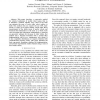ICRA
2003
IEEE
14 years 5 months ago
2003
IEEE
Locomotion is considered as most basic function of robots. In the case of ordinary robots, they are not needed to change locomotion pattern because their configurations are consta...
ICRA
2003
IEEE
14 years 5 months ago
2003
IEEE
In this paper, three fundamental techniques to improve laminated passive elements are proposed for wearable haptic displays. First, a new shape of sheet surfaces in laminated pass...
ICRA
2003
IEEE
14 years 5 months ago
2003
IEEE
We introduce a new method of a biped walking pattern generation by using a preview control of the zeromoment point (ZMP). First, the dynamics of a biped robot is modeled as a runn...
ICRA
2003
IEEE
14 years 5 months ago
2003
IEEE
Abstract— In this paper we address the problem of interpreting sensory data for human-robot interaction, especially when gathered from several robots at the same time. After desc...
ICRA
2003
IEEE
14 years 5 months ago
2003
IEEE
-- In this paper we address the task of human-robot interaction in public mass exposition with several autonomous robots at a time. This implies questions regarding multi-robot con...
ICRA
2003
IEEE
14 years 5 months ago
2003
IEEE
The decades of research in motion planning have resulted in numerous algorithms. Many of the most successful algorithms are randomized and can have widely differing run-times for ...
ICRA
2003
IEEE
14 years 5 months ago
2003
IEEE
— Mapping an environment with an imaging sensor becomes very challenging if the environment to be mapped is unknown and has to be explored. Exploration involves the planning of v...
ICRA
2003
IEEE
14 years 5 months ago
2003
IEEE
— A new 3D biped prototype with small DOF, SKIPPER, was developed. As an important component of a running controller for this robot, an aerial posture controller is presented. Th...
ICRA
2003
IEEE
14 years 5 months ago
2003
IEEE
Probabilistic roadmap (PRM) planners have been successful in path planning of robots with many degrees of freedom, but narrow passages in a robot’s configuration space create s...
ICRA
2003
IEEE
14 years 5 months ago
2003
IEEE
— This paper describes a cooperative method for relative localization of mobile robot teams; that is, it describes a method whereby every robot in the team can estimate the pose ...





